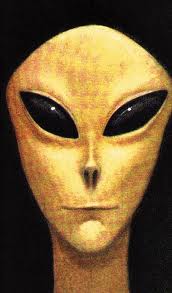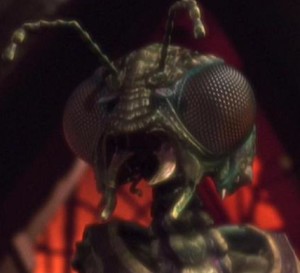“The trouble with having an open mind, of course, is that people will insist on coming along and trying to put things in it.”—Terry Pratchett
 Way back in the Dark Ages, before the internet or cell phones, when only a few had home computers, video rental outlets still dotted the landscape, and CDs were still shiny and new, much of the Western world was just learning of a phenomenon that came to be known as the alien abduction experience from a mind-bending bestseller entitled Communion. As I’ve mentioned elsewhere, I became somewhat obsessed by this idea. Most people who gave the matter any serious consideration at all just assumed that people were being taken by creatures from another planet to be examined out of scientific curiosity, but others knew that something far more profound and insidious was going on. Having been a fan of wildlife shows when I was a kid, especially Mutual of Omaha’s Wild Kingdom, I almost immediately grasped the similarities between what the abductees were reporting and some of the ways that humans go about gathering information from animals.
Way back in the Dark Ages, before the internet or cell phones, when only a few had home computers, video rental outlets still dotted the landscape, and CDs were still shiny and new, much of the Western world was just learning of a phenomenon that came to be known as the alien abduction experience from a mind-bending bestseller entitled Communion. As I’ve mentioned elsewhere, I became somewhat obsessed by this idea. Most people who gave the matter any serious consideration at all just assumed that people were being taken by creatures from another planet to be examined out of scientific curiosity, but others knew that something far more profound and insidious was going on. Having been a fan of wildlife shows when I was a kid, especially Mutual of Omaha’s Wild Kingdom, I almost immediately grasped the similarities between what the abductees were reporting and some of the ways that humans go about gathering information from animals.
Almost every week on Wild Kingdom, biologists accompanied by the ubiquitous Jim (comedians back then used to make jokes about how the show’s host just sat back and narrated while Jim did all of the work) would swoop down on some unsuspecting and suddenly terrified animal in a helicopter, immobilize it with a tranquilizer dart, land their craft and then examine the helpless creature, often tagging them with an electronic tracking device so that they could be located again in the future for further study. Any of this sound familiar to you flying saucer buffs?
The parallels are almost impossible to miss, although many in the UFO field seem to have done so, but others have not. And while I may not have been the first one to have noticed this, it did occur to me before it was pointed out by anyone else. (Pause to high-five myself.) Could it be that this intelligence, whatever it is, feels wholly justified in treating us the same way that we treat less intelligent species? Of course, we do this for the animals’ benefit, but the animals don’t know that. All that they know is what a frightening experience it was, just like the abductees. Do the “aliens” know that we do this for the animals’ benefit? It seems to me that they would have to be pretty thick-headed not to. More importantly, do they feel that they have the right to treat us this way because these abductions are somehow for our benefit?
The major difference is that we can’t communicate with the animals. If we could, we would let them know why we were doing this to them. These beings can communicate with us, at least on a rudimentary level. While it has been speculated that they are incapable of completely explaining to us who or what they are and what they’re doing here, mostly due to our limited intelligence, what is indisputable is that they lie to us about it. They claim to be from all over the galaxy. They give us dire warnings about the dangers of nuclear war and/or what we’re doing to our environment (as if we didn’t already know). And worst of all, they tell some abductees that have been selected to spread the alien gospel because they are special. They are the chosen one.
It’s Occultism 101 to be extremely wary of any entity that tells you that you have been chosen or that you are special. Flattery is a dead giveaway that you’re dealing with something that has ulterior motives and does not have your best interests at heart. It’s better to be told that you’re a know-nothing chucklehead, because at least that’s honest. Aleister Crowley was warning his students about this over a century ago, and it’s highly unlikely that he was the first. Anything that flatters, lies. And the “aliens” have certainly done their share of both. They have given contactees predictions of fairly minor events that turn out to come true, only then to make some bold prediction of impending doom or salvation that some poor dupe is told to shout from the mountaintops. Naturally, when they do, the momentous event doesn’t happen, and the “prophet” becomes a fool and discredits the entire field of study in the process. Obviously, this could be the whole point.
On the other hand, some have been harshly chastised by these beings, as if they were somehow personally to blame for all of the evils of the world, which seems to take the “all are one” philosophy of metaphysics to the point of reductio ad absurdum. Can you really blame an electrician from Duluth for global warming and violence in the Middle East? Maybe that makes sense from some vast perspective of which we have no knowledge, but from down here it just seems silly.
I’ve often wondered what exactly do these beings think of us, and I’ve boiled it down to about fifty possibilities, each of which is contingent upon knowing more about who they are and what they want, which of course I don’t. If they really are just aliens from another planet, then I usually think of it as being one of two possibilities. To them, we are either like ants or rats.
Most people probably don’t like ants. They’re a pest if they’re in your home, and some of their bites can be extremely painful. But entomologists love them. They have highly complex societies, some of which have populations numbering in the millions, with each individual having a well-defined  role. They really are fascinating creatures that we still know relatively little about. The behaviors of some species might actually lead you to believe that they are highly intelligent, despite the fact that most of their brains are about the size of a piece of dirt. There is even one species that captures and enslaves another and forces them to care for their young, not that I’m endorsing that sort of behavior. They seem to act with a single hive mind, which is also seen in a few other types of insects, like bees, and is still a poorly understood concept to us.
role. They really are fascinating creatures that we still know relatively little about. The behaviors of some species might actually lead you to believe that they are highly intelligent, despite the fact that most of their brains are about the size of a piece of dirt. There is even one species that captures and enslaves another and forces them to care for their young, not that I’m endorsing that sort of behavior. They seem to act with a single hive mind, which is also seen in a few other types of insects, like bees, and is still a poorly understood concept to us.
Not many people really study rats, although they can be found in laboratories all over the world. We generally consider rats to be disgusting, repulsive little disease-infested vermin, but their physiology is remarkably similar to our own, making them the perfect subjects for us to conduct all sorts of experiments on while even most animal rights activists don’t raise too much of a fuss. They’re nasty little creatures. Who cares what anyone does to a rat?
But have you considered the possibility that there might be some out there who feel the exact same way about us? With all of our history of greed and violence and man’s inhumanity to man and all of the crap that we’ve done to screw up our own planet, it’s really not that hard to imagine. Is there any other supposedly intelligent species that is so completely self-destructive? It’s possible, but then again we might be the most cannibalistic rats in the universe. And if we are, maybe nobody out there cares what anyone does to us. How could anything that they do be any worse than what we’ve already done to ourselves, especially if some of what they say is true and they know that our days are numbered anyway?
So if there is a higher form of intelligence interacting with us, do they think of us more as ants or rats? Are we in some way interesting and compelling to them, or are they just screwing with us to see how we’ll react, or worse? There’s certainly plenty of evidence that they absolutely are screwing with us, but that by itself doesn’t necessarily prove their indifference to our well-being.
Ethology is an obscure branch of psychology that studies animals, including humans, in their natural environments. Rats don’t live in mazes, they would tell you, and people don’t live their lives the way that they answer questionnaires or respond to laboratory experiments. If you really want to understand a creature’s behavior, you have to observe them in their natural surroundings. This does not, however, keep them from messing with their subjects from time to time. In one famous  experiment, Nobel Prize-winning ethologist Niko Tinbergen noticed that a type of bird called the oystercatcher will lay several speckled eggs, but they only incubate (sit on) the largest one, presumably because the biggest chick will have the best chance for survival. Just to see what they would do, Tinbergen painted speckles on eggs from much larger birds and placed them with some oystercatchers’ real eggs while the mama birds were away. Not too surprisingly, when the mother birds came back, they elected to sit on the eggs that came from the larger birds, despite the fact that some of these eggs were nearly as big as they were.
experiment, Nobel Prize-winning ethologist Niko Tinbergen noticed that a type of bird called the oystercatcher will lay several speckled eggs, but they only incubate (sit on) the largest one, presumably because the biggest chick will have the best chance for survival. Just to see what they would do, Tinbergen painted speckles on eggs from much larger birds and placed them with some oystercatchers’ real eggs while the mama birds were away. Not too surprisingly, when the mother birds came back, they elected to sit on the eggs that came from the larger birds, despite the fact that some of these eggs were nearly as big as they were.
We’re a lot smarter than birds (I hope), but that only means that any such experiments designed for us would have to be far more complex. If we could figure out that we were being screwed with, it would invalidate the experiment. And maybe, just possibly, part of the experiment is not only designed to manipulate us, but also to see how long it takes us to realize that we’re being jerked around. Since Jacques Vallee pointed out fifty years ago that the UFO phenomenon seems to act as a sort of belief control system, he may well have been the first to discover this. If so, they seem not to have rewarded his keen powers of observation and insight by coming clean with him as to what they’re really up to.
Case in point: How will a seemingly ordinary woman who is just picking her kids up from school one day react to seeing an otherwise normal looking man standing in front of a flying saucer, but that flying saucer, and it’s apparent passenger, are hovering over a hundred feet in the air? The paranormal in general and ufology in particular are full of such ridiculous, seemingly pointless occurrences. But unless we’re dealing with lunatics (which is definitely one possibility), there must be some point to it…unless they either don’t know or don’t care what we see most of the time. This idea suggests a different possible interpretation of our relationship with them from their point of view.
Another ant-related comparison that has been made is that we might be like ants living in a nest in a vacant lot in the middle of a city. These ants would have no way of conceiving of creatures like us with our cars and laptops and the espresso machine and free wifi at the inevitable Starbuck’s right next door. And we would pay no attention to them, if we were even aware of them at all. Nevertheless, our proximity to one another would mean that our two separate realities would be bound to intersect at times. They would have no frame of reference for such an encounter, and we most likely wouldn’t even notice them, or care, until one day when some entomologist and her grad students show up to study ant colonies in urban settings. Then both species would become very aware of one another very quickly, no matter how poorly each might understand the other. (You can find just such a study here if you’re interested.) I wonder what those ants thought of all of this unexpected and unprecedented attention from incomprehensible intruders into their reality. Most of them probably weren’t even aware of it, and the ones that were either kept their mandibles shut about it or got made fun of for being crazy.
 Conversely, they might be the ants, although we could still be the rats. Much of what many contactees have described could be interpreted as their abductors operating as a single intelligence. In fact, quite a few have described it exactly that way. The grays seem robotic, unemotional and, some have said, behave as if they’re under the control of some other intelligence, as if they are just automatons or, in the hive context, workers. If they share a collective consciousness, this could be why we have so much trouble understanding each other. Creature with a hive mind might not even understand how traumatic their actions can be to an individual intelligence. This sort of misunderstanding is explored to some extent toward the end of Orson Scott Card’s sci-fi classic Ender’s Game. (I gather that this idea is explored even further in the subsequent Ender novels, but I just read the first one.)
Conversely, they might be the ants, although we could still be the rats. Much of what many contactees have described could be interpreted as their abductors operating as a single intelligence. In fact, quite a few have described it exactly that way. The grays seem robotic, unemotional and, some have said, behave as if they’re under the control of some other intelligence, as if they are just automatons or, in the hive context, workers. If they share a collective consciousness, this could be why we have so much trouble understanding each other. Creature with a hive mind might not even understand how traumatic their actions can be to an individual intelligence. This sort of misunderstanding is explored to some extent toward the end of Orson Scott Card’s sci-fi classic Ender’s Game. (I gather that this idea is explored even further in the subsequent Ender novels, but I just read the first one.)
There is also the possibility that is accepted by some, and has been broadly hinted at to a number of contactees, that they created us, probably by messing around with the genes of proto-humans, perhaps more than once. The implication is that they have been making us more and more like themselves over the millennia. Considering that much of what they do to abductees appears to involve genetic research, with the creation of an alien-human hybrid often being implied as the goal – to the point that some have reported seeing and even holding hybrid children – that’s certainly suggestive of the “aliens as our creators” theory. The likelihood that we would be genetically compatible with some random race of aliens is slim beyond credibility, unless they were somehow related to us. Then again, maybe these alleged hybrids are just the speckled eggs that their version of Niko Tinbergen is using to trick some of us into believing that they are our relatives. Naturally, if we are related, that would still mean that we most likely would have to have had a common ancestor somewhere in the distant past, which opens up a tangent that I’m not even going to go off on here.
So are we ants or rats? Hell if I know. Of course, this whole premise that we are like one or the other of these “lower” forms of life to a wholly separate intelligence just assumes that we are separate and not in some way intimately connected to it. The latter is what I would prefer to believe. Unfortunately, my mindset doesn’t allow me to believe anything, so therefore I have no intellectually honest choice but to consider everything.


 Charles Fort put bread on the table of generations of science fiction writers when, in his 1931 book Lo!, he assembled the many reports of objects and people strangely transposed in time and place, and coined the term “teleportation.” And it took a politician named Ignatius Donnelly to revive lost Atlantis and turn it into a popular subject (again and again and again).1
Charles Fort put bread on the table of generations of science fiction writers when, in his 1931 book Lo!, he assembled the many reports of objects and people strangely transposed in time and place, and coined the term “teleportation.” And it took a politician named Ignatius Donnelly to revive lost Atlantis and turn it into a popular subject (again and again and again).1 By the end of 1945, Amazing Stories was selling 250,000 copies per month, an amazing circulation for a science fiction pulp magazine. Palmer sat up late at night, rewriting Shaver’s material and writing other short stories about the Deros under pseudonyms. Thousands of letters poured into the office. Many of them offered supporting “evidence” for the Shaver stories, describing strange objects they had seen in the sky and strange encounters they had had with alien beings. It seemed that many thousands of people were aware of the existence of some distinctly nonterrestrial group in our midst. Paranoid fantasies were mixed with tales that had the uncomfortable ring of truth. The “Letters-to-the-Editor” section was the most interesting part of the publication. Here is a typical contribution from the issue for June 1946:
By the end of 1945, Amazing Stories was selling 250,000 copies per month, an amazing circulation for a science fiction pulp magazine. Palmer sat up late at night, rewriting Shaver’s material and writing other short stories about the Deros under pseudonyms. Thousands of letters poured into the office. Many of them offered supporting “evidence” for the Shaver stories, describing strange objects they had seen in the sky and strange encounters they had had with alien beings. It seemed that many thousands of people were aware of the existence of some distinctly nonterrestrial group in our midst. Paranoid fantasies were mixed with tales that had the uncomfortable ring of truth. The “Letters-to-the-Editor” section was the most interesting part of the publication. Here is a typical contribution from the issue for June 1946: That same year, Palmer decided to put out an all-flying saucer issue of Amazing Stories. Instead, the publisher demanded that he drop the whole subject after, according to Palmer, two men in Air Force uniforms visited him. Palmer decided to publish a magazine of his own. Enlisting the aid of Curtis Fuller, editor of a flying magazine, and a few other friends, he put out the first issue of Fate in the spring of 1948. A digest-sized magazine printed on the cheapest paper, Fate was as poorly edited as Amazing Stories and had no impact on the reading public. But it was the only newsstand periodical that carried UFO reports in every issue. The Amazing Stories readership supported the early issues wholeheartedly.
That same year, Palmer decided to put out an all-flying saucer issue of Amazing Stories. Instead, the publisher demanded that he drop the whole subject after, according to Palmer, two men in Air Force uniforms visited him. Palmer decided to publish a magazine of his own. Enlisting the aid of Curtis Fuller, editor of a flying magazine, and a few other friends, he put out the first issue of Fate in the spring of 1948. A digest-sized magazine printed on the cheapest paper, Fate was as poorly edited as Amazing Stories and had no impact on the reading public. But it was the only newsstand periodical that carried UFO reports in every issue. The Amazing Stories readership supported the early issues wholeheartedly. A few hundred UFO believers clustered around Coral Lorenzen’s Aerial Phenomena Research Organization (APRO). And about 2,000 teenagers bought Flying Saucers from newsstands each month. Palmer devoted much space to UFO clubs, information exchanges, and letters-to-the-editor. So it was Palmer, and Palmer alone, who kept the subject alive during the Dark Age and lured new youngsters into ufology. He published his strange books about Deros, and ran a mail-order business selling the UFO books that had been published after various waves of the 1950s. His partners in the Fate venture bought him out, so he was able to devote his full time to his UFO enterprises.
A few hundred UFO believers clustered around Coral Lorenzen’s Aerial Phenomena Research Organization (APRO). And about 2,000 teenagers bought Flying Saucers from newsstands each month. Palmer devoted much space to UFO clubs, information exchanges, and letters-to-the-editor. So it was Palmer, and Palmer alone, who kept the subject alive during the Dark Age and lured new youngsters into ufology. He published his strange books about Deros, and ran a mail-order business selling the UFO books that had been published after various waves of the 1950s. His partners in the Fate venture bought him out, so he was able to devote his full time to his UFO enterprises.